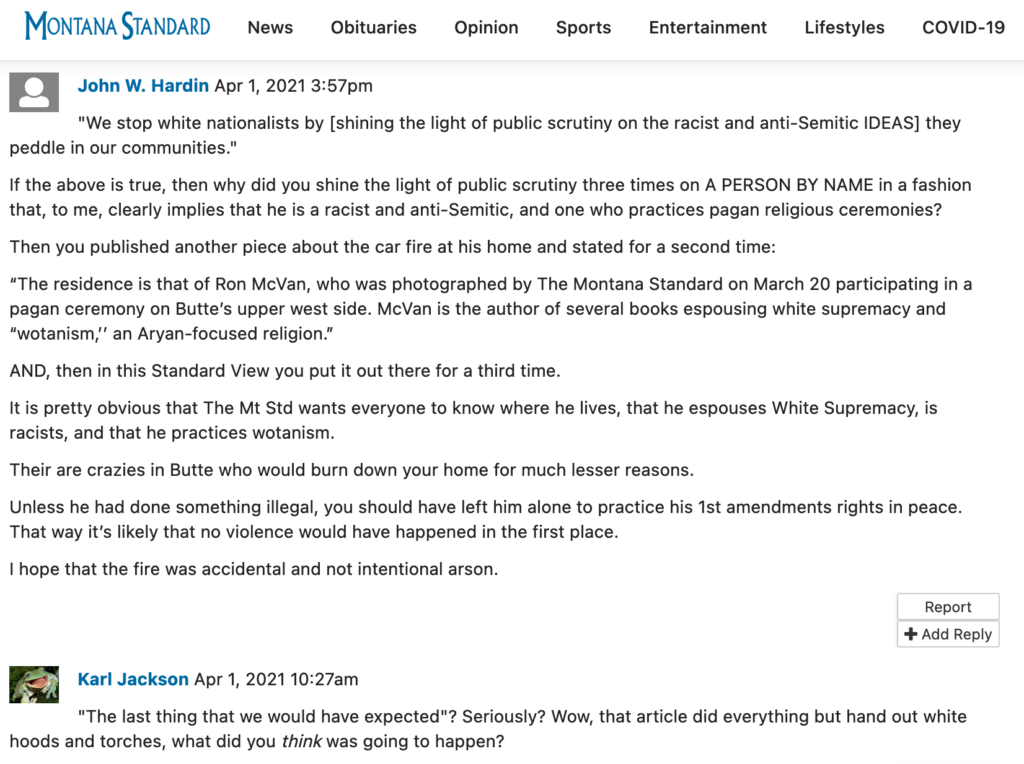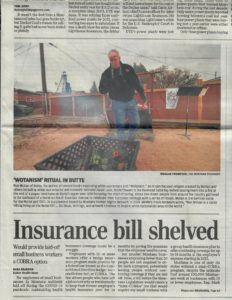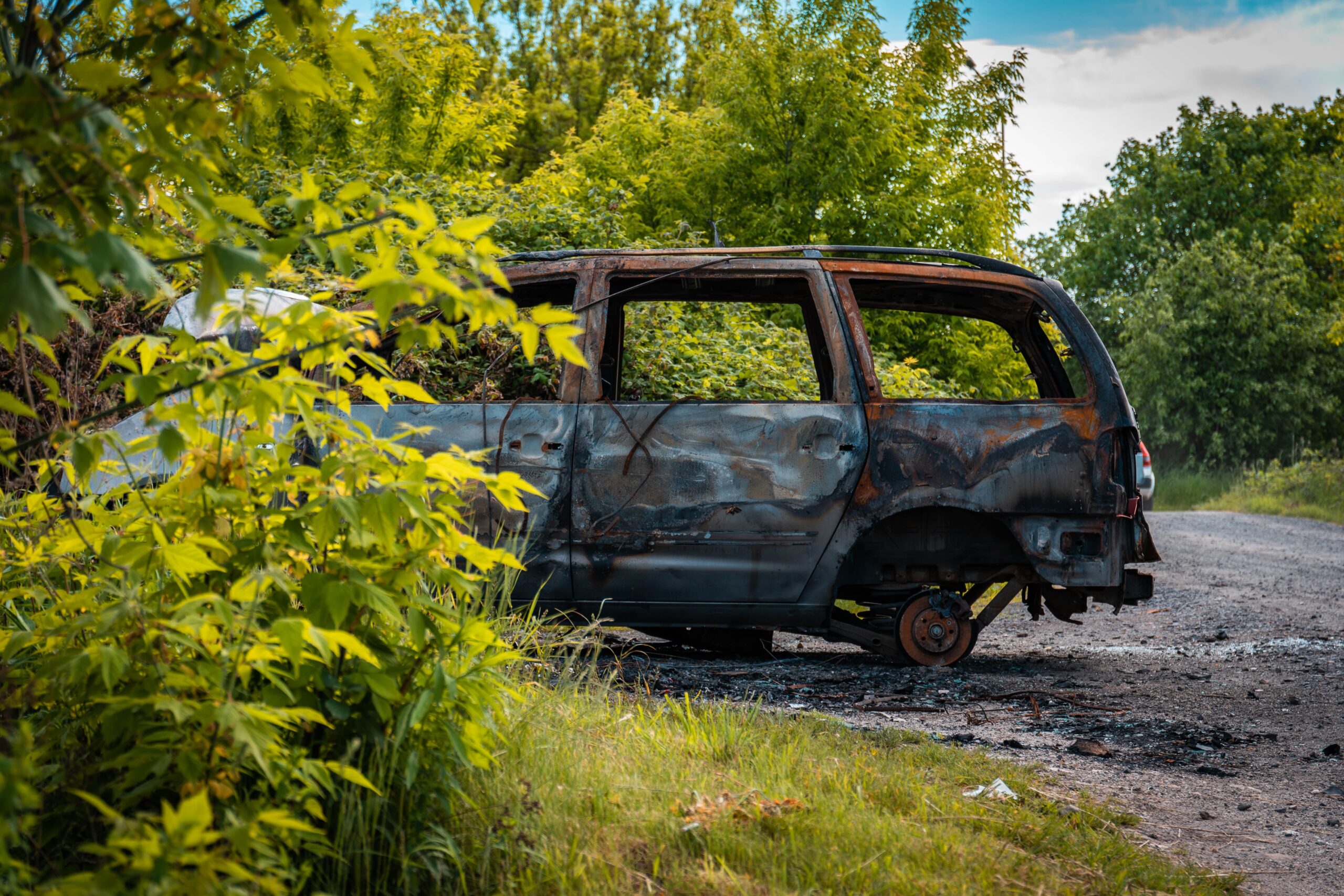If A White Nationalist’s Things Burn Down, Is It A Hate Crime?
Possibly, said the Montana Standard, raising questions of how to cover white nationalists in our communities.
The March 22 front page of the Montana Standard featured “wild art,” a photo that ran without an accompanying story. This photo showed a Butte man pressing flowers to his forehead in front of a fire. Quoting a 2019 report by the Montana Human Rights Network, the caption informed readers that two dozen people had come to town to celebrate a religious rite with Ron McVan, “the author of several books espousing white supremacy and ‘Wotanism.’”
The brief caption left readers with a lot of questions and comments. They thought the Standard had exposed a local extremist, given a platform to a hate group, or slandered people with the term “white supremacist.” In response, the paper ran an editorial explaining and defending the choice as part of their mission to inform the public.
Three days later on March 29, a sudden fire destroyed McVan’s carport and car; he placed the blame on the Standard’s coverage. On April 1, the paper called for the prosecution of the fire — if found to be arson — as a hate crime.
“I saw that picture and I thought, what in the world are they thinking?” says freelance journalist and author Kathleen McLaughlin, a regular contributor to the Washington Post who moved back to Butte last year. “I think there’s a systemic failure here.”

Comments left on the Montana Standard’s site asking about their decision to publish the photo.
The Standard is owned by Lee Enterprises, an Iowa-based corporation that also owns dailies in Helena, Missoula, and Billings. Like McLaughlin, who worked at the Standard when she was in high school and then at Lee’s state capitol bureau, I’m a former Lee employee. I worked at the weekly Missoula Independent for the last year of its existence after Lee bought it from a local independent owner and until they closed it in September 2018. Lee has since consolidated its Montana operations to the point that the paper in Billings, the state’s largest city, no longer has its own editor-in-chief. The Standard’s editor, David McCumber, does that job from Butte, as he does for all the Lee-owned Montana papers.
Local editors work with what they have, which is less and less each year. MTPR Parsing the Press co-host and former Missoulian executive editor Gwen Florio has been in McCumber’s shoes fairly recently. (She resigned last fall after the Missoulian editorial board, in her absence, endorsed a far-right candidate for the state’s Public Service Commission. The endorsement was later retracted.)
She felt last summer that there may have been a story in covering counter-protestors at the city’s Black Lives Matter protesters, but didn’t have the capacity to pursue it. Florio says. “You’re on a hamster wheel all the time. I think it’s more resources — certainly we have the staff with the talent to do it, but they’re stretched really thin.”
For an editor constantly looking for the next front page, a photo like the one featuring McVan is irresistible, she says. “I get the impulse to put it in right away,” she says, “I still think, though, it would have served the paper better and the community better had they waited and done a deeper story.”
Missoula-based journalist Jesse Brenneman, who has reported on the hazards of covering extremism, agrees. That photo also wasn’t sufficient to justify the harm or harassment reporters covering extremism are subject to, which, he says, editorial decision-making needs to account for. Says Brenneman, “If you’re gonna cover these groups it’s gonna get messy. You can’t ever walk through the shit and not get dirty, so you have to make sure there’s a good reason to do it.”
Informing the community that white separatists live among them, along with a description of their beliefs, may satisfy some standards of newsworthiness. But without knowing where to push back, there’s a risk of spreading misinformation or amplifying racist ideas.
“I really hated them saying ‘celebrate their European heritage’” in the photo caption, he says. “Which is propaganda. ‘European heritage’ isn’t a thing. And if people think it is, that’s [the Standard’s] fault.”
Montana Human Rights Network program director Travis McAdam, who lives in Butte, says a longer story would have had room to dive into that. He says he joked to McCumber that the paper should just run the report he’d authored in full when the editor contacted him for comment, rather than just the quote in a caption. He thought the paper had good intentions but was concerned about the execution.

The front page of the Montana Standard on March 22 with a photo of a white supremacist religious ritual. (Source: Susan Elizabeth Shepard)
“We generally feel there is a lot of value in letting communities know when these types of groups are active in their community, but I think to do that in the best possible way you have to provide enough space. You have to provide enough space to where that background and context can be included,” he says.
He says people started contacting him the next day wondering where that context was, wanting to know how concerned they should be, and asking for a lot more context on this racist Odinist sect leader they had just now learned was bringing people to Butte. They were asking him where, and what, was the rest of the story?
“That was one of the things that I did hear over and over again, where people were saying like, ‘What?’ There needed to be more, there needed to be more, there needed to be more, and I think potentially the editor of the Standard was hearing similar things,” he says.
On March 26, the Standard explained why the photo had run immediately without an accompanying story: “The Montana Standard published the photograph because we believe it is important to know that architects of white hate are in our midst” and promised a “more in-depth look at hate groups in our state.” By email, McCumber responded to the question of speed, saying, “The story was news when we published it. That doesn’t prevent us from doing a thoroughgoing followup on hate in the state,” when I asked him about the decision to run the photo instead of waiting for that more in-depth look.
A necessary follow-up was required when McVan’s carport burned down; a Standard staffer filed a photo and brief from the scene the next day. McVan posted the Standard‘s story to Facebook, where he wrote that the fire was the result of the paper’s coverage. His fans spearheaded two online fundraisers, one of which was taken down by GoFundMe, and the other of which is hosted on the website of the Asatru Folk Assembly, in the news recently for opening a whites-only church in Minnesota.
They also began harassing and threatening Standard staffers. McCumber confirmed that the Standard had contacted law enforcement about the threats. The staffers who reported on McVan didn’t respond to a request for comment.
The Standard partially agreed with McVan’s allegations: “[T]he fire has not been confirmed as an arson, although the circumstance of the recent publicity certainly suggests it […] We deeply regret that occurrence, but we reject the fact that such an attack was an inevitable consequence of The Montana Standard revealing his presence in Butte.” McCumber, who authored both editorials concerning McVan, concluded with this: “If this incident is indeed found to be arson, The Montana Standard hopes that the perpetrator is caught and charged with a hate crime.”
By email, McCumber clarified further that McVan’s white nationalist religion would be the basis for a bias crime charge: “We believe that if someone set fire to McVan’s carport out of anger at his religious observance, that certainly could be a hate crime.”
The paper supplied little context by publishing the photo of McVan, a white nationalist. McVan’s carport burnt down. It wasn’t clear if the second was actually a result of the first. But if a white nationalist’s stuff burns down, was it a hate crime?
“You want to prosecute it obviously, but a bias crime? No,” says Florio.
“Of course, it’s not justifiable. Of course, the paper wasn’t saying you should burn these people’s house down,” says Brenneman. “Groups like these are going to try to scapegoat the media and you can’t take the bait and say ‘Oh, sorry. We didn’t mean for it to happen like that.’”
Brenneman says the Standard walked right into accepting McVan’s narrative that he was a victim of the media. “They’re always going to play at being hurt, and the worst thing the media can do is give in to that,” he says. “There are certain people on the far right who would definitely look at something like this and say ‘This is a fantastic example of how the media needs to be more fair to us because if they call us Nazis someone might come burn our garage down!’ And the media cannot take that bait.”
Reporting on ideological extremists can benefit their cause. Study Hall’s own Anti-Fascist Reporting Guide would not have called its first section “Avoiding Any Net Gains for Fascists in Your Reporting” if fascists themselves hadn’t found gains in some coverage; this echoes Data & Society’s 2018 report, The Oxygen of Amplification, which aims to help reporters avoid “the disgust […] of accidentally propagating extremist ideology.” When they don’t like the coverage, they can claim to be victims of a biased media to seek sympathy.
“It’s a tough beat and tough subject matter to deal with. You’re dealing metaphorically with a stick of dynamite,” says Bill Morlin, the former Spokane Spokesman-Review reporter who covered the Montana Freemen, Randy Weaver and the Aryan Nations. “We described Randy Weaver as being a white supremacist and his neighbors and friends said ‘No, no he’s not, you’re picking on him,’ and here’s a guy who had his 10-year-old kid with a rifle and a Nazi swastika armband on,” Morlin says.
And that kind of thing happened a lot. He gives examples of Aryan Nations founder Richard Butler objecting to the use of the word “compound” and of other extremists insisting they were white “separatists” but not “supremacists.” It’s a matter of image management, not accuracy, since the worldviews in question all end up back in the same racist roots. “Some of it’s just a word game,” Morlin says.
McVan’s objection to the term “white supremacist” seems like one of those games. “[McVan] was there at ground level, living with Katja Lane when David Lane was in prison,” he says. “His history is rooted in that whole world and he’s never to my knowledge disavowed any of that.”
Morlin remembers one instance in which an extremist claimed to be the victim of a hate crime. “In the early days of the Aryan Nations, their church was bombed — it caused damage, but not significant damage, there were no injuries or loss of life — and Richard Butler claimed that was a hate crime. But that was Butler making that statement, it wasn’t the local newspaper,” he says.
Bias crime laws are specifically designed to target intent, he says. A fire could be intentional, be arson, and lack the element of motivation. “Until or unless a suspect is identified, proving the motive and intent, you’re never going to know whether or not it was a hate crime.”
Coverage of white nationalists has to take into account the impact on the people most immediately threatened. The Montana Racial Equity Project, based in Bozeman, is the only organization of its kind in Montana: an equity and justice nonprofit with a staff of almost entirely Black and Indigenous people. It hasn’t engaged specifically with this situation, but executive director Judith Heilman says news organizations should be checking in with communities of color whenever they’re covering white supremacy, in part because they are the targets of any potential threat. “Not only are we experts on racism, we also live in our bodies 24/7, 365, so we’re veterans, we’re racism veterans. So consulting with an organization like ours that speaks from lived experience and not just studied knowledge is really good,” Heilman says. “It gives us more insight.”
Despite making different choices around media coverage of far right movements, McCumber and Florio both noted that resources are a major obstacle; McCumber said a Lee investigation into the far right was “awaiting the end of the legislative session because we only have so much reporting bandwidth.”
“Concentrated media like this is not really set up to do the kind of deep reporting and context that responsibly covering the far right requires,” Brenneman says. “The things good journalism requires run contrary to the things that drive monopolists, which is to say making money and concentrating power, and those things are fundamentally in conflict with each other.”
“To use your limited resources to feature someone like that is straight up irresponsible, especially when you’re not doing the work of covering a lot of the important stories in the community,” McLaughlin says. She mentioned an incident from last June in which daycare owner Timber Crooker prohibited pro-police content in her dress code and displayed a banner reading “I Can’t Breathe” on her fence. The parents of one of the children in Crooker’s care, a married couple who are both local law enforcement officers, took to Facebook to post about the policy. Crooker says an onslaught of complaints ensued and her landlords evicted her.
After an initial brief television news story, Crooker says the Standard didn’t find her story newsworthy, and that it and other local outlets failed to follow up on the backlash to the exercise of her free speech rights. “That’s the part that I want people to be upset about. I said ‘Black Lives Matter,’ and the community said, ‘No they don’t, cops do,’” she says. “The media who said they were going to [cover] that never did and the radio stations who said we’re going to talk never contacted me again. Which was frustrating for me for the cause not, for me, as an individual. But for the whole cause. People just let it go.”
Ultimately, the paper’s statement of regret didn’t keep McVan or his followers from posting the names and information of Standard staffers, even after the investigation into the fire was complete. “There was no evidence found that we thought at all that it was any form of arson,” Butte-Silver Bow Fire Marshal Zach Osborne told me on April 29. Their investigation was completed April 6. On May 7, McVan was still posting claims that “self-hating white punks” were responsible.
As of this writing, there hasn’t been a follow-up in the Standard about the fire department’s finding.
Read more
Study Hall’s Anti-Fascist Media Guide
Subscribe to Study Hall for Opportunity, knowledge, and community
$532.50 is the average payment via the Study Hall marketplace, where freelance opportunities from top publications are posted. Members also get access to a media digest newsletter, community networking spaces, paywalled content about the media industry from a worker's perspective, and a database of 1000 commissioning editor contacts at publications around the world. Click here to learn more.
